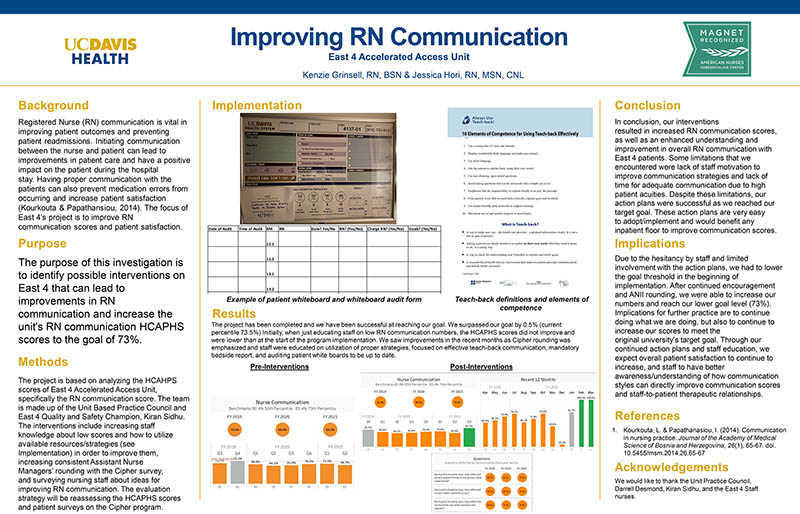
Hover to pan and click to magnify. Click again to pan at full screen.
Kenzie Grinsell, RN, BSN & Jessica Hori, RN, MSN, CNL
Kenzie Grinsell, RN, BSN & Jessica Hori, RN, MSN, CNL
UC Davis Health East 4 Accelerated Access Unit
ABSTRACT
Registered Nurse (RN) communication is vital in improving patient outcomes and preventing patient readmissions. Initiating communication between the nurse and patient can lead to improvements in patient care and have a positive impact on the patient during the hospital stay. Having proper communication with the patients can also prevent medication errors from occurring and increase patient satisfaction (Kourkouta & Papathansiou, 2014). The focus of East 4’s project is to improve RN communication scores and patient satisfaction. The purpose of this investigation is to identify possible interventions on East 4 that can lead to improvements in RN communication and increase the unit's RN communication HCAPHS scores to the goal of 73%. The project is based on analyzing the HCAHPS scores of East 4 Accelerated Access Unit, specifically the RN communication score. The team is made up of the Unit Based Practice Council and East 4 Quality and Safety Champion, Kiran Sidhu. The interventions include increasing staff knowledge about low scores and how to utilize available resources/strategies in order to improve them, increasing consistent Assistant Nurse Managers’ rounding with the Cipher survey, and surveying nursing staff about ideas for improving RN communication. The evaluation strategy will be reassessing the HCAPHS scores and patient surveys on the Cipher program.The project has been completed and we have been successful at reaching our goal. We surpassed our goal by 0.5% (current percentile 73.5%) Initially, when just educating staff on low RN communication numbers, the HCAPHS scores did not improve and were lower than at the start of the program implementation. We saw improvements in the recent months as Cipher rounding was emphasized and staff were educated on utilization of proper strategies, focused on effective teach-back communication, mandatory bedside report, and auditing patient white boards to be up to date. In conclusion, our interventions resulted in increased RN communication scores, as well as an enhanced understanding and improvement in overall RN communication with East 4 patients. Some limitations that we encountered were lack of staff motivation to improve communication strategies and lack of time for adequate communication due to high patient acuities. Despite these limitations, our action plans were successful as we reached our target goal. These action plans are very easy to adopt/implement and would benefit any inpatient floor to improve communication scores.

DISQUS COMMENTS WILL BE SHOWN ONLY WHEN YOUR SITE IS ONLINE